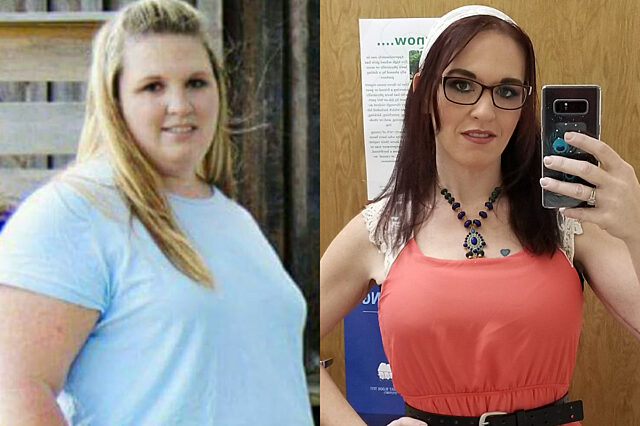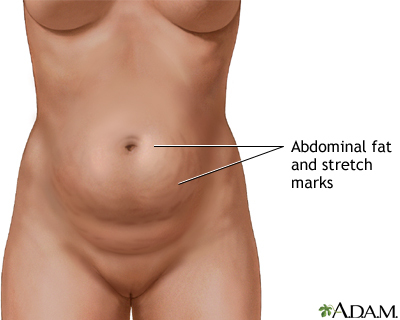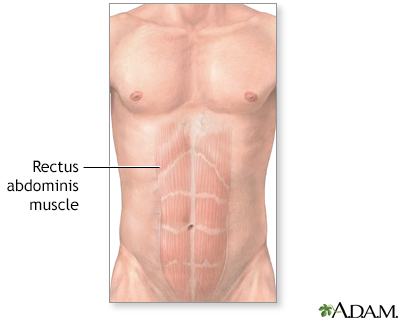Before and After: Christina’s Complete Transformation at UF Health
At her biggest, Christina Mandeville — a mother of three — was 350 pounds and suffering from multiple ailments. UF Health dramatically turned her life around,…

Update your location to show providers, locations, and services closest to you.
Abdominal wall surgery is a procedure that improves the appearance of flabby, stretched-out abdominal (belly) muscles and skin. It is also called a tummy tuck. It can range from a simple mini-tummy tuck to more extensive surgery.
Abdominal wall surgery is not the same as liposuction, which is another way to remove fat. But, abdominal wall surgery is sometimes combined with liposuction.
Cosmetic surgery of the abdomen; Tummy tuck; Abdominoplasty
Your surgery will be done in an operating room in a hospital. You will receive general anesthesia. This will keep you asleep and pain-free during the procedure. The surgery takes 2 to 6 hours. You can expect to stay in the hospital for 1 to 3 days after surgery.
After you receive anesthesia, your surgeon will make a cut (incision) across your abdomen to open up the area. This cut will be just above your pubic area.
Your surgeon will remove fatty tissue and loose skin from the middle and lower sections of your abdomen to make it firmer and flatter. In extended surgeries, the surgeon also removes excess fat and skin (love handles) from the sides of the abdomen. Your abdominal muscles may be tightened also.
Mini abdominoplasty is performed when there are areas of fat pockets (love handles). It can be done with much smaller cuts.
Your surgeon will close your cut with stitches. Small tubes called drains may be inserted to allow fluid to drain out of your cut. These will be removed later.
A firm elastic dressing (bandage) will be placed over your abdomen.
For less complicated surgery, your surgeon may use a medical device called an endoscope. Endoscopes are tiny cameras that are inserted into the skin through very small cuts. They are connected to a video monitor in the operating room that allows the surgeon to see the area being worked on. Your surgeon will remove excess fat with other small tools that are inserted through other small cuts. This surgery is called endoscopic surgery.
Most of the time, this surgery is an elective or cosmetic procedure because it is an operation you choose to have. It is not usually needed for health reasons. Cosmetic abdomen repair can help improve appearance, particularly after a lot of weight gain or loss. It helps flatten the lower abdomen and tighten stretched skin.
It may also help relieve skin rashes or infections that develop under large flaps of skin.
Abdominoplasty can be helpful when:
This procedure is a major surgery. Be sure you understand the risks and benefits before having it.
Abdominoplasty is not used as an alternative to weight loss.
Risks for anesthesia and surgery in general are:
Risks for this surgery are:
Tell your surgeon or nurse:
Before surgery:
On the day of surgery:
You will have some pain and discomfort for several days after surgery. Your surgeon will prescribe pain medicine to help you manage your pain. It may help to rest with your legs and hips bent during recovery to reduce pressure on your abdomen.
Wearing an elastic support similar to a girdle for 2 to 3 weeks will provide extra support while you heal. You should avoid strenuous activity and anything that makes you strain for 4 to 6 weeks. You will probably be able to return to work in 2 to 4 weeks.
Your scars will become flatter and lighter in color over the next year. DO NOT expose the area to sun, because it can worsen the scar and darken the color. Keep it covered when you are out in the sun.
Most people are happy with the results of abdominoplasty. Many feel a new sense of self-confidence.


Padilla PL, Khoo KH, Ho T, Cole EL, Sirvent RZ, Phillips LG. Plastic surgery. In: Townsend CM Jr, Beauchamp RD, Evers BM, Mattox KL, eds. Sabiston Textbook of Surgery. 21st ed. St Louis, MO: Elsevier; 2022:chap 69.
Richter DF, Schwaiger N. Abdominoplasty procedures. In: Rubin JP, Neligan PC, eds. Plastic Surgery, Volume 2: Aesthetic Surgery. 4th ed. Philadelphia, PA: Elsevier; 2018:chap 23.


At her biggest, Christina Mandeville — a mother of three — was 350 pounds and suffering from multiple ailments. UF Health dramatically turned her life around,…
